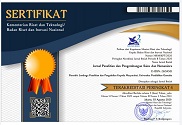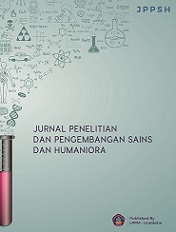Environmental Responsibility Disclosures by Agricultural Companies in Indonesia
DOI:
https://doi.org/10.23887/jppsh.v5i2.37177Keywords:
Tanggung Jawab Lingkungan, Air dan Limbah, Standar GRI 2016, Perusahaan AgrikulturAbstract
Penelitian ini bertujuan untuk mengetahui tingkat pengungkapan yang disajikan dalam laporan keberlanjutan oleh tujuh perusahaan pertanian dengan fokus pada limbah dan efluen berdasarkan standar GRI. Penelitian ini menggunakan pendekatan deskriptif kualitatif dengan analisis isi dan lembar coding. Analisis isi akan digunakan dengan mengklasifikasikan kriteria tertentu berdasarkan kelompok pengungkapan dan lembar kode digunakan sebagai instrumen penelitian untuk menganalisis pola naratif yang disajikan. Hasil penelitian menunjukkan bahwa pemenuhan efluen dan limbah di SR perusahaan pertanian Indonesia relatif rendah dan belum detail. Lebih lanjut, itu juga menyarankan bahwa pengungkapan lebih kompatibel dengan Standar GRI.References
Alhaj, A. (2019). Sustainability Disclosure on Environmental Reporting: A Review of Literature in Developing Countries. American Based Research Journal, 8(2019–01), 01–13. https://www.researchgate.net/publication/331543249.
Almira, L. F., & Fuad. (2015). Pengaruh Pengungkapan Sosial dan Lingkungan Terhadap Asimetri Informasi Bagi Investor (Studi Empiris Pada Perusahaan Manufaktur yang Terdaftar di BEI Tahun 2012-2013). Diponegoro Journal of Accounting, 4(4), 541–551. http://ejournal-s1.undip.ac.id/index.php/accounting.
Amran, A., & Haniffa, R. (2011). Evidence in Development of Sustainability Reporting: a Case of a Developing Country. Business Strategy and the Environment, 20(3), 141–156. https://doi.org/https://doi.org/10.1002/bse.672.
Bernard, S., Abdelgadir, S., & Belkhir, L. (2015). Does GRI Reporting Impact Environmental Sustainability? An Industry-Specific Analysis of CO2 Emissions Performance between Reporting and Non-Reporting Companies. Journal of Sustainable Development, 8(9), 190. https://doi.org/10.5539/jsd.v8n9p190.
Berthelot, S., Coulmont, M., & Serret, V. (2012). Do Investors Value Sustainability Reports? A Canadian Study. Corporate Social Responsibility and Environmental Management, 19(6), 355–363. https://doi.org/10.1002/csr.285.
Branco, M. C., & Rodrigues, L. L. (2006). Communication of Corporate Social Responsibility by Portuguese Banks: A Legitimacy Theory Perspective. Corporate Communications, 11(3), 232–248. https://doi.org/10.1108/13563280610680821.
Burhan, A. H. N., & Rahmanti, W. (2012). the Impact of Sustainability Reporting on Company Performance. Journal of Economics, Business, and Accountancy | Ventura, 15(2), 257–272. https://doi.org/10.14414/jebav.v15i2.79.
Ching, H. Y., Gerab, F., & Toste, T. H. (2017). The Quality of Sustainability Reports and Corporate Financial Performance: Evidence From Brazilian Listed Companies. SAGE Open, 7(2). https://doi.org/10.1177/2158244017712027.
Eriyanto. (2013). Pengantar Metodologi untuk Penelitian Ilmu Komunikasi dan Ilmu-ilmu Sosial Lainnya (Kencana (ed.)). Prenadamedia Group. https://books.google.co.id.
GRI. (2016a). GRI 101: Fundamental 2016. Gssb, 1(1), 30. https://www.globalreporting.org.
GRI, G. R. I. (2016b). GRI 306: Effluents and Waste. GRI Standards, 2016(December), 1–13. https://www.globalreporting.org.
Junior, R. M., & Best, P. (2017). GRI G4 Content Index: Does It Improve Credibility and Change The Expectation – Performance Gap of GRI-Assured Ustainability Reports ? Sustainability Accounting, Management and Policy Journal, 8(5), 571–594. https://doi.org/10.1108/SAMPJ-12-2015-0115.
Koesmawardhani, N. W., & Wardani, H. L. (2017). Hutan Jadi Industri Perkebunan, Orangutan pun Dianggap Hama. DetikNews. https://news.detik.com/berita/d-3447217/hutan-jadi-industri-perkebunan-orangutan-pun-dianggap-hama.
Krippendorff, K. (2018). Content Analysis: An Introduction to Its Methodology (Fourth Edi). SAGE Publication, Inc. https://books.google.co.id.
Kurniawan, T., Sofyani, H., & Rahmawati, E. (2018). Pengungkapan Sustainability Report dan Nilai Perusahan: Studi Empiris di Indonesia dan Singapura. Kompartemen: Jurnal Ilmiah Akuntansi, 16(1), 1–20. https://doi.org/10.30595/kompartemen.v16i1.2100.
Laoli, W. B., & Davianti, A. (2019). Health and Safety Disclosures Practice in Indonesian Chemical Industries : A Qualitative Content Analysis Study. International Journal of Social Science and Business, 3(4), 348–357. https://doi.org/http://dx.doi.org/10.23887/ijssb.v3i4.21321.
Muryono, S. (2018, September). Warga Menemukan Limbah Pabrik Kelapa Sawit Mengalir ke Sungai. Antara News. https://www.antaranews.com/berita/744360/warga-menemukan-limbah-pabrik-kelapa-sawit-mengalir-ke-sungai.
Primadhyta, S., & Perkasa, A. (2018). Dana “Panas” Sawit Maybank Rp34 T Rusak Hutan Indonesia. CNN Indonesia. https://www.cnnindonesia.com/ekonomi/20180228090606-78-279330/dana-panas-sawit-maybank-rp34-t-rusak-hutan-indonesia.
Rosen, M. A. (2017). The Future of Sustainable Development: Welcome to the European Journal of Sustainable Development Research. European Journal of Sustainable Development Research, 1(1), 1–2. https://doi.org/10.20897/ejosdr.201701.
Tarigan, J., & Semuel, H. (2015). Pengungkapan Sustainability Report dan Kinerja Keuangan. Jurnal Akuntansi Dan Keuangan, 16(2), 88–101. https://doi.org/10.9744/jak.16.2.88-101.
Visser, W., & Brundtland, G. H. (2013). Our Common Future (‘The Brundtland Report’): World Commission on Environment and Development. The Top 50 Sustainability Books, 52–55. https://doi.org/10.9774/gleaf.978-1-907643-44-6_12.
Downloads
Published
Issue
Section
License
Authors who publish with the Jurnal Penelitian dan Pengembangan Sains dan Humaniora agree to the following terms:
- Authors retain copyright and grant the journal the right of first publication with the work simultaneously licensed under a Creative Commons Attribution License (CC BY-SA 4.0) that allows others to share the work with an acknowledgment of the work's authorship and initial publication in this journal.
- Authors are able to enter into separate, additional contractual arrangements for the non-exclusive distribution of the journal's published version of the work (e.g., post it to an institutional repository or publish it in a book), with an acknowledgment of its initial publication in this journal.
- Authors are permitted and encouraged to post their work online (e.g., in institutional repositories or on their website) prior to and during the submission process, as it can lead to productive exchanges, as well as earlier and greater citation of published work. (See The Effect of Open Access)









